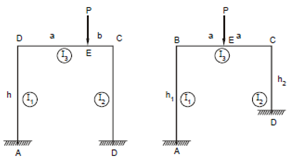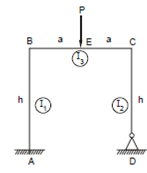Sway Due to Unsymmetrical Loading:
Sway is not only possible due to horizontal loads, but due to lack of symmetry either in loading or support conditions or geometrical properties of the portal.
In Figure (a), the loading is unsymmetric (a and b), being unequal even though the portal is symmetric. Hence, there will be a sway. In Figure 18(b), the load is symmetrically placed on the beam but the columns being of unequal height causes unsymmetry in the structure and hence, sway will take place. Sway will take place even in Figure 18(c) where the lack of symmetry may be due to different type of supports on the two sides (fixed at A, hinged at D) or due to unequal moments of inertia (I1 ≠ I2).

(a) Sway Due to Unsymmetrical Loading (b) Sway Due to Unsymmetrical Geometry of Frame

(c) Sway Due to Unsymmetrical Support
The sway BB′ causes a chord rotation of member AB (similarly, CC′ for member DC). Due to this chord rotation, fixed end moments - 6EI Δ/l2 will be introduced at either end of the member where Δ = BB′.
Now, we shall take the case of symmetrical portals loaded with symmetrical loads only, in the example below. The moment distribution is carried out in a similar tabular form as used for continuous beams.